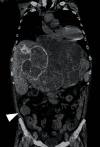A Case of Liver Metastasis from Small Intestinal Gastrointestinal Stromal Tumor 25 Years after Surgery including Autopsy Findings
- PMID: 33680520
- PMCID: PMC7929657
- DOI: 10.1155/2021/6642427
A Case of Liver Metastasis from Small Intestinal Gastrointestinal Stromal Tumor 25 Years after Surgery including Autopsy Findings
Abstract
Gastrointestinal stromal tumor (GIST) is the most common mesenchymal tumor in the digestive tract. Recurrences may occur even after radical resection; however, recurrence later than 10 years after surgery is rare. We report a case of GIST with recurrence of liver metastasis 25 years after surgery. A 56-year-old man complained of sudden epigastric pain and was transferred to the emergency department. He had undergone partial resection of the small intestine for leiomyosarcoma 25 years previously. Abdominal computed tomography showed multiple liver tumors with massive hemorrhage. Ultrasound-guided percutaneous biopsy was performed for the 15-mm hepatic tumor in segment 2. Pathological findings revealed proliferation of spindle-shaped atypical cells, and immunostaining for c-kit and CD34 was both positive; the patient was therefore diagnosed with GIST. He then underwent chemotherapy for 7 years but died of multiple organ failure due to GIST. Autopsy revealed GIST occupying the entire liver with peritoneal dissemination, and minute lung metastases that could not be identified by CT were also detected. This case is interesting in considering the recurrence of GIST, and we will report it together with the literature review.
Copyright © 2021 Yuichi Takano et al.
Conflict of interest statement
The authors declare that they have no conflicts of interest.
Figures









References
Publication types
LinkOut - more resources
Full Text Sources
Other Literature Sources

